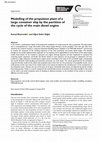Papers by Oguz Salim Sogut
Renewable Energy, Jul 1, 2005
Applied Energy, Sep 1, 2005
International Journal of Energy Research, 2006
International Journal of Vehicle Design, 1999

Proceedings of the Institution of Mechanical Engineers, Part C: Journal of Mechanical Engineering Science, Mar 30, 2009
An optimal performance analysis of a parabolic-trough direct-steam-generation solar-driven Rankin... more An optimal performance analysis of a parabolic-trough direct-steam-generation solar-driven Rankine cycle power plant at maximum power (MP) and under maximum power density (MPD) conditions is performed numerically to investigate the effects of heat loss from the heat source and working fluid. In this study, the ideal Rankine cycle of the solar-driven power plant is modified into an equivalent Carnot-like cycle with a finite-rate heat transfer. The main assumptions of this study include that: (a) the parabolic collector is the thermal reservoir at a high temperature, (b) the heat transfer process between the collector and the working fluid is through either radiation and convection simultaneously or radiation only, and (c) the heat transfer process from the working fluid to the low-temperature thermal reservoir is convection dominated. Comprehensive discussions on the effect of heat loss during the heat transfer process from the hot thermal reservoir to the working fluid in the parabolic-trough solar collector are provided. The major results of this study can be summarized as follows: (a) the working fluid temperature at the hot-side heat exchanger decreases remarkably whereas the working fluid temperature at the cold-side heat exchanger does not show any significant change with increasing heat loss, (b) the MP, MPD, and thermal efficiencies decrease with increasing heat loss, and (c) the effect of heat loss on the decrease of thermal efficiency increases when convection is the dominant heat transfer mode at the hot-side heat exchanger.
International journal of applied thermodynamics, Sep 1, 2017

The paper reports on the results of a theoretical investigation on the computer-aided simulation ... more The paper reports on the results of a theoretical investigation on the computer-aided simulation of a diesel engine under variable load conditions. The variable load conditions were simulated by altering the amount of fuel injection to engine cylinders. The computer simulation program employs the well established Method of Characteristics to simulate the unsteady gas flow in the intake and exhaust manifolds of the engine. A heat release scheme is employed for the in-cylinder calculations and a turbocharger simulation routine is also incorporated into the code. For the validation of the results, the MTU 16V 396 TB34 D stationary diesel generator engine data were used. The variable load conditions of 1/4th of the full load up to full load in 1/4th increments and 10% overload conditions were considered. The measured and calculated values for the effective power, mean effective pressure, specific fuel consumption and thermal efficiency were compared and found to be in good agreement.

This paper deals with a theoretical investigation of the influence of different heat release rate... more This paper deals with a theoretical investigation of the influence of different heat release rates on the performance curves of a diesel engine. The study was further extended to determine the theoretical optimum heat release rate diagram without exceeding the construction constraints of the engine. A marine diesel engine of 16 cylinders, 4 valve per cylinder, direct injection supercharged type was considered. A well proven computer programme for the complete simulation of diesel engines was employed in the study. The computer code is capable of simulating the unsteady gas flow in the manifolds, in cylinder processes and the turbocharger. The maximum combustion pressure, specific fuel consumption and effective power of the engine cylinders were compared for the different heat release rate cases. The time resolved pressure curves for the intake and exhaust manifolds were also included and the effects of different heat release rates on these diagrams were analyzed.
Journal of ETA Maritime Science, 2017

Proceedings of the Institution of Mechanical Engineers, Part M: Journal of Engineering for the Maritime Environment, 2019
In this article, a mathematical replica of the propulsive installation of a large container ship ... more In this article, a mathematical replica of the propulsive installation of a large container ship is presented. The ship propulsion is accomplished by a large two-stroke marine diesel engine driving a marine propeller. The main new idea introduced by this research consists in using the Subsystem-Enabling feature available in the MATLAB Simulink® environment to control the execution of the working sequences of the main propulsion two-stroke diesel engine. The benefits brought by this model implementation approach are its simplicity and its applicability to all the blocks of the diesel engine model, these blocks can be created to represent one engine working sequence and then duplicated to represent the remaining engine sequences, and finally, the blocks related to each sequence can be grouped in subsystems and controlled by a single subsystem monitoring the engine events according to the value of the crankshaft angle; consequently, the overall Simulink model building and execution pro...
International Journal of Thermodynamics, 2017

International Journal of Exergy, 2016
The effect of heat leakage from a twin-spool turbofan engine to the ambient air on the performanc... more The effect of heat leakage from a twin-spool turbofan engine to the ambient air on the performance of the engine for a commercial aircraft is investigated. Effects of heat leakage on the variation of the performance indicators of coefficient of ecological performance, overall efficiency, exergy destruction factor, thrust specific fuel consumption and entropy generation rate with respect to the design parameters of compressor and fan pressure ratios, by-pass ratio and turbine inlet temperature are investigated numerically. The main findings are as follows: (i) Effect of heat leakage from the combustion chamber to the by-pass air on the coefficient of ecological performance, exergy destruction factor and entropy generation rate is considerably large when compared to that on the other performance indicators especially for small values of design parameters except for turbine inlet temperature. (ii) Effect of heat leakage on the performance indicators is significant for small values of turbine inlet temperature and large values of the other design parameters.
SAE Technical Paper Series, 1991
Engineering technical paper: The Use of Gas Dynamics to Link In-Cylinder and Exhaust System Unbur... more Engineering technical paper: The Use of Gas Dynamics to Link In-Cylinder and Exhaust System Unburnt Hydrocarbon Measurements on a Spark Ignition Engine.
Sustainable Maritime Transportation and Exploitation of Sea Resources, 2011










Uploads
Papers by Oguz Salim Sogut